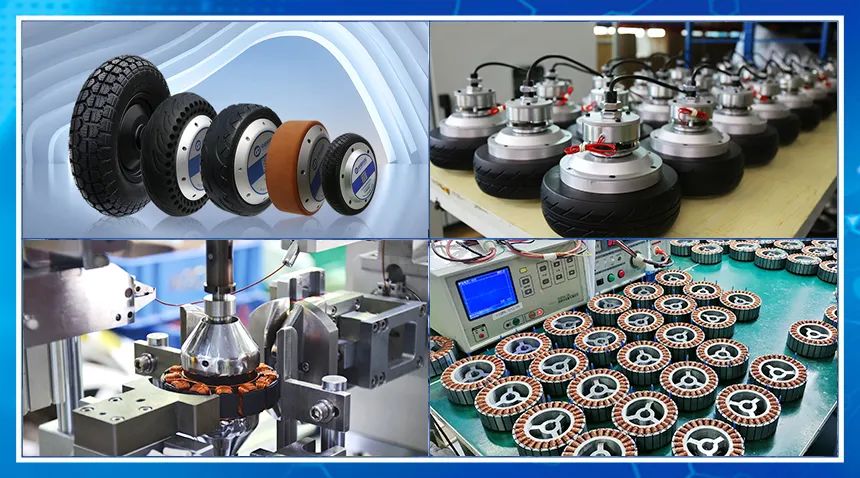As users of in-wheel motors, we definitely hope that the efficiency of in-wheel motors can be maximized. During the operation of in-wheel motors, losses will inevitably occur. If we want to improve efficiency, we must first understand what it is. Loss of energy in the motor.
1. Iron consumption
Iron loss is the loss of the motor core and end iron parts. It is mainly divided into two types: "hysteresis loss" and "eddy current loss".
a. Hysteresis loss
The magnetic flux in the transformer moves on the iron core. The iron core has magnetic resistance to the magnetic flux, just like a conductor has resistance to current, and it also generates heat. We call this loss "hysteresis loss". In order to reduce the influence of hysteresis loss and reduce the associated energy loss, ferromagnetic materials with low coercivity and low hysteresis loss, such as permalloy, are used.
b. Eddy current loss
Because the iron core itself is also a conductor, an electric potential will be induced on a plane perpendicular to the magnetic field lines. This electric potential forms a closed loop on the cross section of the iron core and generates an electric current, like a vortex, which is called an "eddy current." This "eddy current" increases the loss of the transformer and increases the temperature rise of the transformer's core heating transformer. Generally, the eddy current loss is much larger than the hysteresis loss.
2. Copper consumption
There are two types of copper loss, the electrical energy loss of the stator winding and the electrical energy loss of the rotor winding. Due to the resistance in the stator and rotor windings, electrical energy loss occurs when current passes through, which is called copper loss. The size of copper loss is proportional to the square of the current passing through the hub motor. Copper loss is the most "arrogant" among all losses in the motor. They do not need to be hidden, so it is very easy to calculate. It is only related to the current and the resistance of the winding. When the current flows into the winding, it absorbs it desperately , and the current is related to the motor torque.
3. Mechanical loss
The types of mechanical losses are quite complex. No matter what state the wheel hub motor is running in, mechanical losses can account for at least 20% of the total losses of the wheel hub motor. Mainly divided into "wind friction loss" and "stray loss".
a. Wind friction loss
Wind friction loss is bearing friction and ventilation loss. It corresponds to the power consumed by bearing friction and ventilation resistance, and its size is related to the roughness of the rotor surface and the rotation speed. The mechanism of its generation is very simple. When the motor rotor rotates, it appears due to the existence of air resistance. The faster it rotates, the stronger it is.
b. Stray loss
When the stator winding passes current, a certain amount of copper loss will occur. For most motors, the stator and rotor windings "flow" with alternating current. For some rotors without windings (permanent magnets), this is ignored. The alternating current current The direction of the magnitude changes. The so-called changing current produces a changing magnetic field. When the motor speed rises and the frequency of the current rises to a certain level, a huge induced electromotive force will be generated in the center area of the winding wire. Since the central area of the wire has a closed The existence of a loop will lead to the generation of induced current. The induced current is always opposite to the other. It always hinders the change of the original current. Therefore, a blockage area will be formed in the center of the conductor cross-section, and the trajectory of the current flow will tend to The outer part of the wire cross-section is the legendary "skin effect". The result of the "skin effect" is that the cross-sectional area of the wire decreases, the resistance of the wire increases, and the energy loss of the AC current penetrating the winding wire has an additional addition. This "addition" "Cheng" is stray loss. The size of stray losses can be determined through the loss analysis method of motor testing.
The above is the analysis of the factors that affect the loss of in-wheel motors. It can be known that in-wheel motors are mainly affected by three major factors: iron loss, copper loss and mechanical loss. Usually the measures to reduce these losses are through the production process and in-wheel motor. Adjust the materials to reduce the value of each loss so that the wheel hub motor meets the standard requirements.
Shenzhen Zhongling Technology is a company that has long been committed to motor and drive industrial automation. Its products have been distributed with customers all over the world. It is recognized and trusted by customers by virtue of its high stability. It has taken a leading position in the industry and has always adhered to the concept of continuous innovation to bring the best products to customers. A complete R&D and sales system provides customers with the best purchasing experience.
Mailbox:[email protected]
Office address:303, 3rd Floor, Building B, Fenghuang Zhigu, Tiezi Road, Xixiang Street, Bao'an District, Shenzhen
Factory address:6th Floor, Building D, Changxing Zhigu Industrial Park, No. 16 Changlong Xinfeng Street, Huangjiang Town, Dongguan City